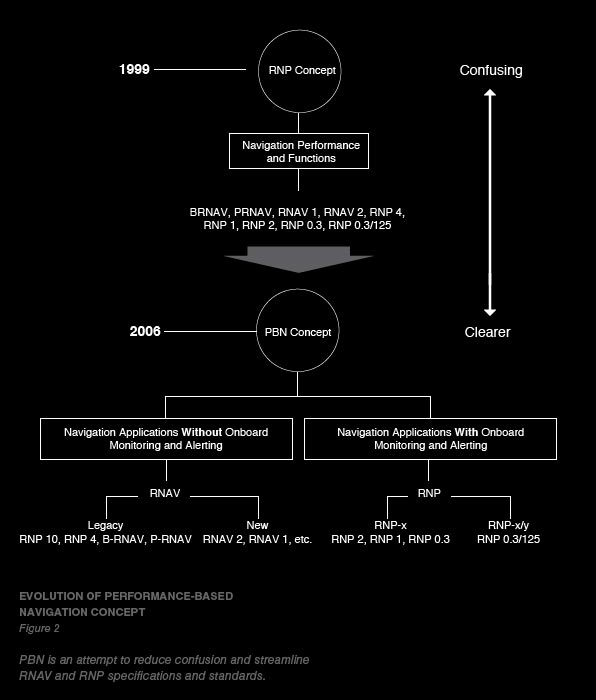
THE MOVE TO PBN
The FAA defines PBN as “a framework for defining navigation performance requirements that can be applied to an air traffic route, instrument procedure, or defined airspace.” PBN, which comprises both RNAV and RNP specifications, provides a basis for the design and implementation of automated flight paths that will facilitate airspace design, traffic flow, and improved access to runways.
The PBN concept began with an assessment of all current and near-term implementations of RNAV and RNP, including basic RNAV (BRNAV) standards, precision RNAV (PRNAV), RNAV 1, RNAV 2, RNP < 1, RNP 1, RNP 2, RNP 4, and RNP 10. Part of the goal of PBN is to consolidate these various implementations to alleviate confusion and streamline operations (see fig. 2). RNAV now includes BRNAV, PRNAV, RNAV 1, RNAV 2 and RNP 10 (now RNAV 10), and RNP now includes RNP < 1, RNP 1, RNP 2, and RNP 4. This consolidation provides better guidance on how to apply RNAV and RNP and what it means to airspace, traffic management, air traffic control, and the commercial air service infrastructure.
Because RNAV and RNP are part of PBN, lateral navigation standards for performance, functionality, and capability are intrinsic to it. PBN has the potential to provide operators with more efficient airspace and instrument procedures that can improve safety, access, capacity, and efficiency, while minimizing environmental impacts. With PBN, all navigation aspects of operations — including terminal airspace — will be defined, developed, and implemented on the basis of operational requirements and the associated required performance.
More detailed information is provided in the PBN Manual, which is available on the ICAO Web site (www.icao.int). It will be issued as a major revision and replacement to the existing RNP Manual, Document 9613.


